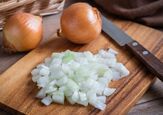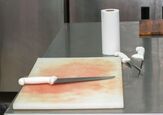Spackle Vs. Joint Compound: Which Is Better For Covering Holes?

When repairing sheetrock, or prepping walls for paint, you have the option to use spackle, and joint compound. Each one has its uses, so we’re going to break down the differences between the two, as well as when to use them.
Spackle is used for filling small holes in a wall, in preparation for paint. It can be used to fill nail holes, pinholes, and other small blemishes. Joint compound is used for floating drywall and doing sheetrock patches, and repairs.
I’ve used my fair share of both of these products. Spackle is lightweight, and great for preparing a wall for paint. Joint compound, on the other hand, is much thicker and is used primarily for large repairs.
The type of project you are working on may call for one or both of these, depending on the amount of work you are doing.
Do You Need to Hire Drywall Installers?
Get free, zero-commitment quotes from pro contractors near you.

Types of Spackle
There is more than one type of spackle. Each one has its purpose, and you will need to choose the right kind, based on the work you will be doing.
Spackling types:
- Lightweight
- Vinyl
- Standard
- Epoxy
- Acrylic
Lightweight spackle is used for small pinholes and fine cracks. The smaller the imperfections, the lighter you want your spackling to be.
Vinyl spackle is used for holes that are at least ¾ deep. Use it in layers, and let it dry between layers. It is thick and heavy.
Standard Spackle is a general-purpose spackling. Use it on deeper holes and imperfections. Lightweight spackling will crack in deep holes, while standard spackling will hold up.
Epoxy spackle is used to fill small holes in wood. It is an oil-based product, it’s a heavyweight, and it holds up well over time on wooden surfaces.
Acrylic spackle is used for deep holes. It can be used on drywall, brick, wood, or plaster, and sets up fast. Use this for larger holes.
What is Joint Compound?
Joint compound is used in drywall. It is applied to sheetrock taped joints, and spread out, to get an even float. It is sandable and is the standard that is used for doing sheetrock repairs, and drywall work in general.
Joint compoud comes in a powder form, that you add water to, and it also comes ready to go in a bag/box. You may still need to add water to the premixed joint compound, to get different results.
The best part about the joint compound is that it is sandable. You may decide to use joint compound instead of spackling to be able to sand it to a smooth finish.
You may also be able to use joint compound, instead of spackle, for small holes. Just keep in mind that it is not as versatile as spackle, and could crack if used in thinner amounts.
Differences Between Spackle Vs. Joint Compound
There are many differences between spackle and joint compound. Let’s take a look at those differences, and how they can help you decide which of the two is right for your project.
| Spackle | Joint Compound |
| Spackle is used for small holes, up to the size of a nickel. | The joint compound is used when hanging new sheetrock or doing sheetrock repairs. |
| Certain types of spackle, such as vinyl, is flexible and will shrink some. | Joint compound is thick and can be put on in multiple layers, without shrinking. |
| Spackle comes in multiple types, vinyl, standard, acrylic, and more. | There is only one type of joint compound, however, it comes in a powder form and a premixed form. |
| Most repaints use spackle to fill small holes, from thumbtacks and hairline cracks. | Joint compound is your go-to, for sheetrock repairs of all sizes. |
Now that you know the differences, you can better understand, when and where to use each of these products.
When Not Use Spackle
There are some projects that you will want to avoid using spackle on. Follow these best practices to properly use spackle.
- Spackle is flexible and may shrink. Do not use spackling, if shrinking is a problem, or if you are only going to be using one coat. It oftentimes takes more than one layer of spackle, to get a good even fill.
- Do not use spackle in place of joint compound. Spackle is not meant to fill large areas, such as sheetrock patches, or when hanging and finishing drywall. The joint compound is designed to not shrink.
- Do not use the wrong type of spackling. If your surface requires you to use a standard or lightweight spackle, do not use an acrylic or epoxy spackle. You may not be able to sand it or paint over it with the base of paint you are using.
Spackle definitely has its uses, but make sure you are using it correctly on the right type of surfaces. Always read the directions.
When Not Use Joint Compound
Joint compound is great for a few different types of projects, however, it is not so great for other projects. Keep these best practices in mind, when using a joint compound.
- Do not use joint compound on wood. Joint compound is meant to work with drywall and gypsum board surfaces. It sticks really well to drywall but doesn’t hold up so well on other surfaces.
- Use spackle instead of joint compound, on small holes. Joint compound tends to crack if used in too thin of an amount. While it can be used in place of spackling, in a pinch, spackling is always your best choice for small holes.
- Never use joint compound without priming it afterward. If you do not prime the joint compound, you will get “flashing” and the areas using the joint compound will be seen through the paint.
Joint compound is primarily used for drywall only. You can’t go wrong with joint compound on the drywall.
Pros and Cons of Spackle
Spackle has a few pros and cons, so we have put together this chart to show you what is good about it, and what is bad. Keep in mind, that the correct use, depends on what surface you are applying it to.
| Spackle Pros | Spackle Cons |
| Luckily, spackle is easy to get off of your hands. As long as it is a water base spackle. Use a pumice product if you are using oil-based spackle. | This product does not work well on larger holes, or areas that need repair. Only use it for small holes and blemishes. |
| Spackle comes in a ready-to-use formula. You can get spackle in a small tub or a tube that squeezes the product out. | Spackle can not be used to seal a surface properly. Do not use spackling for sealing. It is for filling holes only. |
Spackling is a great product for small situations. Almost every hardware store carries it, and it is relatively cheap.
Pros and Cons of Joint Compound
Just like with spackling, joint compound has its pros and cons. Let’s look at each, to see why joint compounds might be right for your project.
| Joint Compound Pros | Joint Compound Cons |
| The finish that joint compound provides, is smooth and high quality. It is the standard for sheetrock repairs and floating. | The joint compound is extremely thick and heavy. Mixing it up, and carrying it around can be a hassle. |
| Joint compound is easy to apply. It goes on smooth with a mud knife. You can get knives that are multiple sizes. | Does not do well on very small cracks or blemishes. If you are using joint compound in the place of spackle, it could crack. |
I have put on a ton of joint compound in my day. Drywall is hard work, and working with mud (joint compound) can be very messy! Make sure you wear clothes that you do not care about getting dirty.
Spackle or Joint Compound for Cracks
When you have cracks you may be wondering which of these to use, a spackle or joint compound. The answer depends on the size of the cracks.
If the cracks are hairline cracks, then you should use spackle to fill them. The spackle is flexible and will expand and contract with the crack.
If the cracks are very large and deep, you will want to consider using a joint compound, instead of a spackle. You may have to apply more than one layer, and then sand it down for a smooth surface.
If your house is settling, and you see cracks appear, such as above door frames or windows, make sure that the settling has passed before applying either of these. If it is still in the process of settling, you will have to redo the cracks multiple times.
Techniques for Using Spackle
When using spackle there are a few techniques, that I have found work very well in the application.
- Use a putty knife to apply the spackling. In some cases, you can use your finger and wipe away the access with your hand. But if you want a good looking surface, use a putty knife and scrape the excess spackle away, leaving as little as possible.
- Spackle works best for small pinholes. If you have a wall that is riddled with pinholes, from posters, such as in a teenagers room, then spackle will be your go-to filler. It is a thin material, that fills holes easily.
- Carry a wet rag with you. Spackle can dry on your hands, and be hard to remove, for this I always carry a wet rag with me. You can also use the wet rag to wipe away the excess spackling from the wall, making a much smoother surface.
Tips for Using Joint Compound
Joint compound is used in almost every single home. It seals the drywall, and is used to texture the surface. Here are some tips that will help you effectively use joint compound.
- Use a mud pan. The joint compound is messy, and you will need to use a mud pan to hold your compound. You will be able to place the mud, and the sheetrock knife, into the pan for easy access.
- If you are putting on multiple coats, let them dry. Wait for your coats of joint compound to dry, before adding the next coat. In most cases, you will also want to sand in between coats.
- Have a bucket with water handy. Keep a 5-gallon bucket full of water around you. You may need to add water to your compound, to get a different consistency, depending on how you are using it. The water can also be used to clean your mud knife.
Do You Need to Hire Drywall Installers?
Get free, zero-commitment quotes from pro contractors near you.

Related Questions
Can I use wood filler instead of spackle?
Wood filler should only be used on wood. If you are working with drywall, you will want to use spackle or joint compound. For exterior trim boards, or wood used inside, you would use wood filler.
Is joint compound the same as drywall mud?
Yes, joint compound, and drywall mud, are one and the same. The product goes by joint compound, drywall mud, or just mud.

We are a team of passionate homeowners, home improvement pros, and DIY enthusiasts who enjoy sharing home improvement, housekeeping, decorating, and more with other homeowners! Whether you're looking for a step-by-step guide on fixing an appliance or the cost of installing a fence, we've here to help.
More by Upgraded Home Team

























![Cost To Drill A Well [Pricing Per Foot & Cost By State]](https://cdn-fastly.upgradedhome.com/media/2023/07/31/9074980/cost-to-drill-a-well-pricing-per-foot-cost-by-state.jpg?size=350x220)

